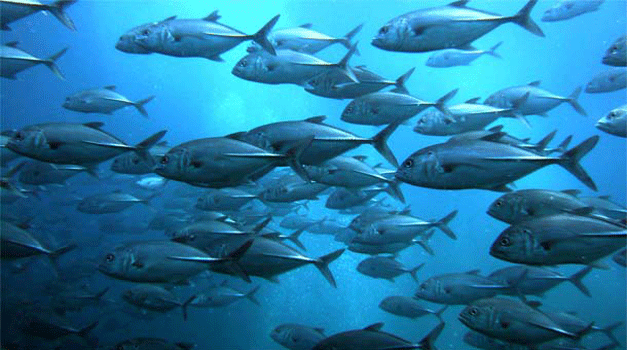If you haven’t already seen it, I recommend watching The end of the line. Last week I finally saw this five-year-old documentary based on the book by English journalist Charles Clover. It describes how high-tech modern fishing is destroying ocean ecosystems. Some major species of fish, including blue fin tuna, cod, and many others, are being decimated. Unlike traditional fishing, a restrained art that requires skill and respect of the prey, industrial fishing is ruthlessly effective, and with the high demand from industrialized countries and growing economies such as China, it is a highly lucrative business.
Don’t get me wrong, I love fresh fish in any form, raw in sushi or nicely simmered in a paella or a bouillabaisse. The movie gave me pause, though, and I added a new resolution to my new year’s list: buy fish on the sustainable list only.
What does this have to do with our current preoccupation with contraceptives vs. fertility awareness, you may wonder?
Two things, at least:
- The fish themselves
- The human behavior in general
The fish
It turns out that industrial fishing is not the only way we are harming our underwater friends. You need to hear about ethinyl estradiol (EE2). EE2 is a component in most hormonal contraceptives and the cause of two major problems. The first problem is that women who use hormonal contraceptives eliminate this chemical in their urine, and we’re finding it in waste waters in industrialized countries. The second problem is that EE2 messes up fishes’ hormones and causes infertility in male fish.
For instance, in a study started in 1990, scientists put a very small amount of EE2 in a lake and observed that the Flathead Minnow became almost extinct from its exposure[i]. In 2009, The New York Times revealed how these chemicals were causing fish in the Potomac to become intersex (have both male and female organs). A report published in the current issue of Fish & Shellfish Immunology adds to “a growing body of research pointing to problems with estrogen in the nation’s waterways.”
The European Commission considered a regulation on EE2 to protect European water and its wild life, but then postponed action on it because it would mean removing “very low (part per trillion) levels of EE2 from waste water effluents at considerable expense,” wrote Susan Jobling[ii], an expert on the environmental effects of EE2. Jobling suspects that the commission’s inertia was fueled by the short-sighted apathy of the general public, “which has enjoyed decades of flexible fertility and will also ultimately pay for the control and management of its unintended consequences.” Are we sacrificing the future on the altar of our desperation to avoid pregnancy at all costs and the greed of those who stand to gain from it?
The behavior
There are several parallels between the fish story in The end of the Line and the story of contraception in our society. Both tell a story of greed of large corporations and organizations, willful ignorance of human and environment balances, government apathy (or collusion), and about our culture of unbridled desires.
We see the greed and apathy in the large corporations that manufacture and sell contraceptives, and in the medical system that chooses to endorse it and profit from their distribution. It is quite shocking to hear that the American Academy of Pediatric recently recommended intrauterine devices (IUDs) and other long-acting reversible contraceptives (LARCs) to teens.
We also witness the manipulation of facts to make us believe that contraceptives are OK, that pregnancy is much more dangerous that birth control, after all – on that point, my question is: why is it so dangerous for women to be pregnant in the US? How come in the 21st century we’re not better able to protect pregnant women from death? The reality is that the United States ranks 136th in the world in maternal death[iii], with a rate of 21 to 27 death per 100,000! That’s 7 to 10 times higher than rates in Estonia, Greece, Singapore and Belarus! Since when are these countries equipped with better technology than the U.S.?
Governmental apathy is clear in the U.S., to say the least. The Food and Drug Administration (FDA) doesn’t restrict the distribution of these dangerous drugs even after many cases of death. By positioning contraceptive drugs as a basic healthcare need for women, the Affordable Care Act (ACA) gave a huge promotional push for the contraceptive industry. While a woman told me this week: ”Depo Provera is evil,” and many others have shared how harmful this potent drug is, some local governments are getting massive federal grants to give it for free to low-income teens.
Last but not least, our own difficulty with changing our ways and dealing with our natural (and good!) appetites is likely to lead to future negative consequences, similarly to the downstream effects of ineffective, or altogether lacking, removal of female sex hormones from wastewater. These methods of birth control are habit-forming, for the women[iv] who take them and for the men who “benefit” from them. For people who are used to making love any time they want (even if they don’t do it that often), to imagining that there would ever be a good reason to wait is a challenge. One common misunderstanding is that with natural family planning or fertility awareness methods, couples will have less sex, when in fact they likely will have more for a longer time in their life, and with more fulfillment, but not necessarily whenever they want.
It’s a bit like our relationship to the fish: we can still enjoy tuna and cod and other fish with moderation, but we can’t have it as much as we want, if we hope to still have some around for our children 30 years from now. We can ignore nature and the need for balance and respect of our bodies in our sexual life as well, but at what costs?
On the other end of the spectrum, natural family planning and fertility awareness is a bit like traditional fishing: moderate, respectful of the environment, a skill, even an art.
So my heartfelt wishes for this New Year go to the fish in the ocean, and to the health and love life of every woman in the world!
References
[i] Two recent articles on this topic: http://www.theprovince.com/technology/Study+finds+birth+control+pill+negative+effects+lake/10285542/story.html
[ii] “Ethinyl oestradiol in the aquatic environment” by Susan Jobling and Richard Owen, 2012 file:///C:/Users/Gerard/Downloads/Late%20lessons%20Vol%20II_chapter13%20(1).pdf
[iii] Two different sources quote similarly high numbers:
https://www.cia.gov/library/publications/the-world-factbook/rankorder/2223rank.html
http://data.worldbank.org/indicator/SH.STA.MMRT
[iv] On this topic, Holly Grigs-Spall makes a strong case in her book Sweetening the Pill, How we got hooked on birth control. Read also https://naturalwomanhood.org/youre_not_yourself_on_the_pill/







